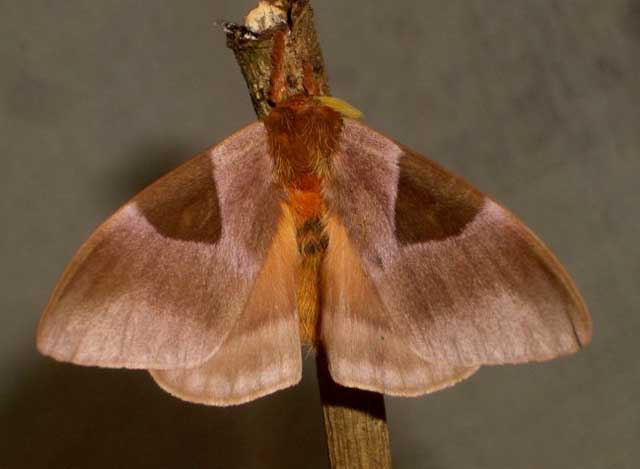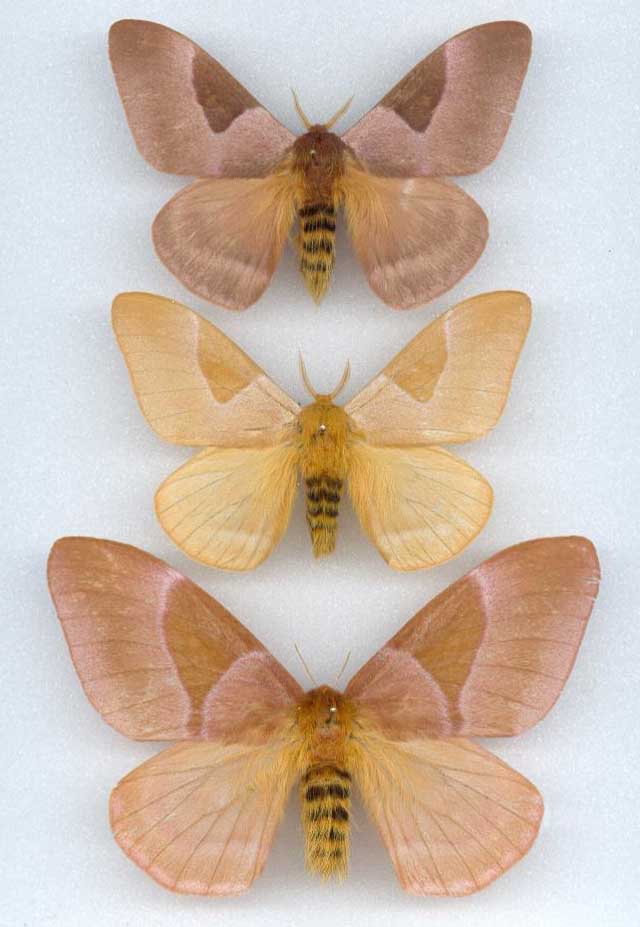Dirphia aviluisiana
Dirphia aviluisiana
Brechlin & Meister, 2011

Dirphia aviluisiana male, Colombia,
September 21, 2008, courtesy of Ana Jaramillo.

Dirphia aviluisiana male, 83mm, Radisson, Panama, Panama,
April 19, 2015, courtesy of Tony James.
| TAXONOMY:
Superfamily: Bombycoidea, Latreille, 1802
Family Saturniidae Boisduval, [1837] 1834
Subfamily: Hemileucinae, Grote & Robinson, 1866
Tribe: Hemileucini, Grote & Robinson, 1866
Genus: Dirphia, Hubner, 1819
|
MIDI MUSIC
"What.A.Wonderful.World"
copyright C. Odenkirk
MIDI CITY
ON.OFF
<bgsound src="world.mid" LOOP=FOREVER>
|
DISTRIBUTION:
Dirphia aviluisiana
(wingspan: males: 72-79mm; females: 103mm // Mfwl: 38-42mm; Ffwl: 53mm) flies in
Colombia: Antioquia: San Luis at 500m; Cundinamarca?? (WO); and possibly into eastern Venezuela.
Recently BOLD systems has added Costa Rica and Panama to the range for D. aviluisiana
This species seems much more orangey brown, even yellowish on the hindwings, than other species, and more regularly the abdomen is bright yellow with black rings.
For those reasons I have added the images of the moth from Radisson, Panama, to this page. Both images are of the same moth and it is interesting how the lighting
seems to affect the colouration of the wings.

Dirphia aviluisiana male, 83mm, Radisson, Panama, Panama,
April 19, 2015, courtesy of Tony James, id by Bill Oehlke.

Dirphia aviluisiana male, 83mm, Radisson, Panama, Panama,
April 19, 2015, courtesy of Tony James, id by Bill Oehlke.
Based on Entomo-Satsphingia Jahrgang 4 Heft 5 29.12.2011, the Dirphia avia Group (darker median sub-triangular shape, running from costa toward
inner margin without striga) consists of the following species:
allae Brechlin & Meister 2011, Peru: Ayacucho; Apurimac; Cusco; Puno; Madre de Dios; Ucayali;
Junin; Pasco;
avia French Guiana; Venezuela; probably Guyana and Suriname; most of Central America
avibarinasensis Brechlin & Meister 2011, Venezuela: Barinas
avichoco Brechlin & Meister 2011, Colombia: Choco
aviluisiana Brechlin & Meister 2011, Colombia: Antioquia; Cundinamarca?;
aviurica Brechlin & Meister 2011, Peru: Piura;
Tumbes
avinapoana Brechlin, Meister & Kaech 2011,
Ecuador: Napo; Zamora Chinchipe;
Peru: Amazonas; San Martin
aviboliviana Brechlin & Meister 2011, Bolivia: La Paz; Chuquisaca;
Beni; Tarija; Santa Cruz; Cochabamba;
avialtoparanensis Brechlin & Meister 2011, Paraguay: Alto Parana; Paraguari
cadioui Lemaire, 1980,
Argentina; Bolivia
curitiba Draudt, 1930 Brazil
dentimaculata Schaus, 1921
Brazil; possibly
Paraguay
muscosa Schaus, 1898 southeastern
Brazil;
northeastern Argentina
Ormiscodes hortensia Schaus, 1913, Brazil, is same as muscosa
f. sinuosa Bouvier, 1929, Brazil, is same as muscosa
f. colorata Bouvier, 1930, Brazil, is same as muscosa
nora (Druce, 1897) Panama: Chiriqui
triangulum Walker, 1855 southeastern Brazil: Santa Catarina; Rio de Janeiro; probably Sao Paulo; Minas Gerais; Parana.

Dirphia aviluisiana trio, Cundinamarca, Colombia,
S. Bonilla and L. D. Ramirez, courtesy of Thibaud Decaens.
Regarding the image directly above, the lower two specimens, lighter, more yellowish in colour, show a great resemblance
to D. aviluisiana from Antioquia, Colombia, as depicted in the Entomo-Satsphingia journal, and I believe them to be
that species. The upper, darker male, may be a darker form of that species or it may be Dirphia avia. Bill Oehlke
FLIGHT TIMES AND PREFERRED FOOD PLANTS:
Thus far recorded in August and September, this species probably broods continuously as conditions permit.
Larvae feed upon West Indian Locust (Hymenaea courbaril) and West Indian Cedar (Cedrela odorata).

Dirphia aviluisiana female, Venezuela,
courtesy of Eric van Schayck, tentative id by Bill Oehlke.
I have posted the above image to this file, primarily based on shape of forewing outer margin, and also because of overall yellowish, brighter tint to the
ground colour. It was sent to me as Dirphia avia, but female avia seem to have a much more evenly rounded forewing outer margin, and tend to be either
greyish or brown.
ECLOSION, SCENTING AND MATING:
Males use highly developed antennae to locate females at night by tracking their airbourne pheromone plumes.
In the image to the right, female curls her abdomen to deposit eggs.EGGS, LARVAE, COCOONS AND PUPAE:White eggs with a black micropyle (probably) are laid in large clusters and larvae feed gregariously.
Typical of the Subfamily Hemileucinae, Dirphia species all have urticating spines.
The species name is indicative to a close relationship with and similar appearance to D. avia and a specimens type locale in San Luis, Colombia.
It is hoped that this alphabetical listing followed by the common name of the anticipated foodplant will prove useful. The list is not exhaustive. Experimenting with
closely related foodplants is worthwhile.
Cedrela odorata
Crataegus oxyacantha......
Fagus sylvatica
Hymenaea courbaril
Malus
Prunus
Quercus ilex
Salix
|
West Indian Cedar
English hawthorn
European Beech
West Indian Locust
Apple
Cherry/Plum
Holly/Holm oak
Willow
|
Use your browser "Back" button to return to the previous page.
Return to Dirphia Genus
Goto Mexican and Central American Saturniidae Directory
Goto South American Saturniidae Directory
Goto Main Saturniidae Index




